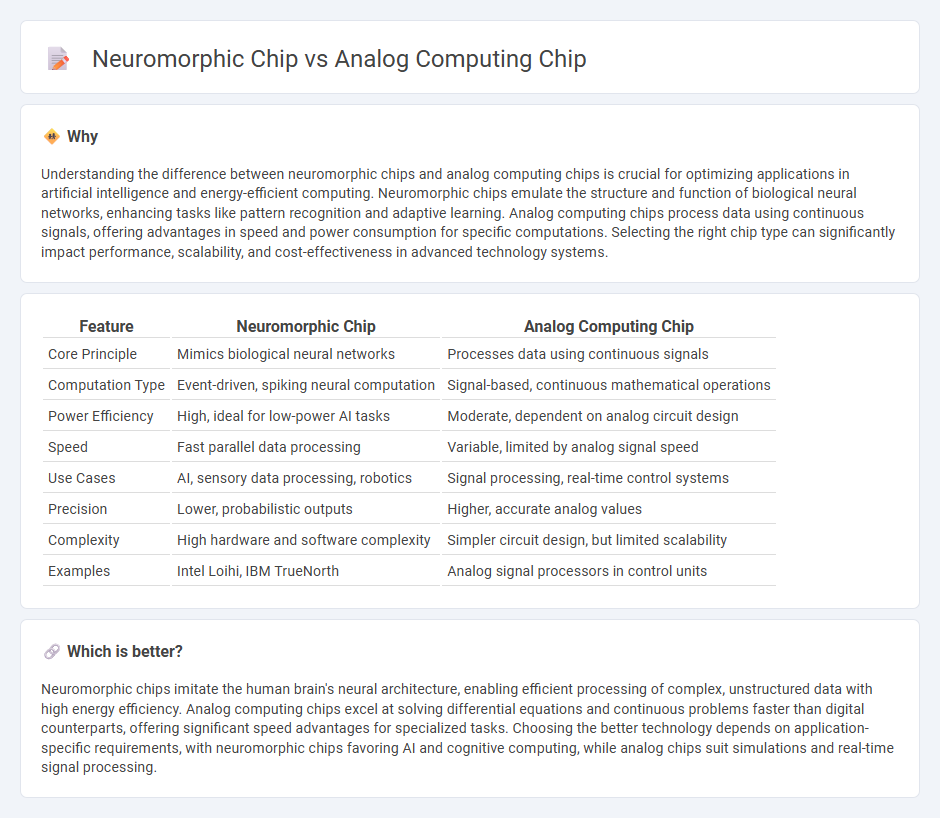
Neuromorphic chips mimic the neural structures of the human brain to enhance AI processing efficiency, while analog computing chips utilize continuous signals for faster, low-power computation in specific tasks. Neuromorphic technology excels in pattern recognition and sensory data interpretation, whereas analog chips are preferred for real-time simulations and solving differential equations. Explore the detailed differences and applications of neuromorphic versus analog computing chips to understand their impact on future technology.
Why it is important
Understanding the difference between neuromorphic chips and analog computing chips is crucial for optimizing applications in artificial intelligence and energy-efficient computing. Neuromorphic chips emulate the structure and function of biological neural networks, enhancing tasks like pattern recognition and adaptive learning. Analog computing chips process data using continuous signals, offering advantages in speed and power consumption for specific computations. Selecting the right chip type can significantly impact performance, scalability, and cost-effectiveness in advanced technology systems.
Comparison Table
| Feature | Neuromorphic Chip | Analog Computing Chip |
|---|---|---|
| Core Principle | Mimics biological neural networks | Processes data using continuous signals |
| Computation Type | Event-driven, spiking neural computation | Signal-based, continuous mathematical operations |
| Power Efficiency | High, ideal for low-power AI tasks | Moderate, dependent on analog circuit design |
| Speed | Fast parallel data processing | Variable, limited by analog signal speed |
| Use Cases | AI, sensory data processing, robotics | Signal processing, real-time control systems |
| Precision | Lower, probabilistic outputs | Higher, accurate analog values |
| Complexity | High hardware and software complexity | Simpler circuit design, but limited scalability |
| Examples | Intel Loihi, IBM TrueNorth | Analog signal processors in control units |
Which is better?
Neuromorphic chips imitate the human brain's neural architecture, enabling efficient processing of complex, unstructured data with high energy efficiency. Analog computing chips excel at solving differential equations and continuous problems faster than digital counterparts, offering significant speed advantages for specialized tasks. Choosing the better technology depends on application-specific requirements, with neuromorphic chips favoring AI and cognitive computing, while analog chips suit simulations and real-time signal processing.
Connection
Neuromorphic chips mimic the brain's neural architecture by using analog computing principles to process information efficiently through continuous signals rather than binary digital states. Analog computing chips enable these neuromorphic systems to perform real-time parallel processing with low power consumption, closely replicating synaptic functions and neural plasticity. This synergy between neuromorphic design and analog computation accelerates advancements in artificial intelligence by enhancing pattern recognition and sensory data analysis.
Key Terms
Signal Processing
Analog computing chips process signals using continuous voltage levels, offering high precision and low power consumption for real-time signal processing tasks like filtering and modulation. Neuromorphic chips mimic neural architectures, excelling at pattern recognition and adaptive learning in noisy signal environments through spiking neural networks. Explore the latest innovations in signal processing by delving deeper into these advanced chip technologies.
Synaptic Plasticity
Synaptic plasticity, a key mechanism for learning and memory, is fundamentally different in analog computing chips and neuromorphic chips; analog chips use continuous signals to mimic synaptic weights, allowing fine-grained strength adjustment, while neuromorphic chips emulate biological neural networks with adaptive synapses that dynamically change through spike-timing-dependent plasticity (STDP). Neuromorphic architectures offer enhanced energy efficiency and on-chip learning capabilities, making them more suitable for real-time adaptive applications such as robotics and AI. Explore how these technologies harness synaptic plasticity to revolutionize computation and cognitive processing.
Parallelism
Analog computing chips leverage continuous signals to perform simultaneous computations, enabling highly efficient parallelism for tasks involving real-time data processing and signal analysis. Neuromorphic chips mimic the brain's neural architecture by using spiking neurons and synapses, providing massive parallelism tailored for pattern recognition and adaptive learning with low power consumption. Explore the distinct parallelism capabilities and applications of these chips to understand their impact on next-generation computing technologies.
Source and External Links
New analog AI chip design uses much less power for AI tasks - IBM Research developed an analog AI chip leveraging phase-change memory to perform multiply-accumulate operations efficiently within memory, achieving up to 14 times better energy efficiency for AI workloads, though challenges remain for precision and manufacturing scale.
Power-efficient analog compute for edge AI - Mythic - Mythic's analog computing technology integrates AI parameters directly into the processor, eliminating memory bottlenecks and delivering significantly improved power efficiency, cost savings, and speed for edge AI applications compared to digital chips.
Analog AI - IBM Research - IBM uses phase-change memory in analog AI inference chips with millions of synaptic cells to build neural networks that perform energy-efficient AI inference by continuously varying analog signals instead of digital bits.
 dowidth.com
dowidth.com